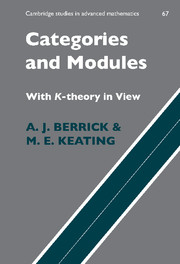5 - Limits in Categories
Published online by Cambridge University Press: 12 October 2018
Summary
Although it is natural to commence the study of modules with finitely generated modules, there are many occasions when it is necessary to consider modules that are not be finitely generated. For example, we shall see that many common and useful examples of flat modules are not finitely generated. The main topic of this chapter, the formation of the direct limit of a set of modules, provides a useful tool for the construction and analysis of non-finitely generated modules in terms of finitely generated modules. In the next chapter, we see how localizations of rings and modules are obtained as direct limits.
The general properties of direct limits are discussed in the first section of this chapter, with an emphasis on limits of modules. We then give two applications of these results. The first is to the theory of flat modules, where we obtain several characterizations of such modules, including Lazard's Theorem. The second is to direct limits of rings, where we give examples of von Neumann regular rings, which can be regarded as ‘infinite-dimensional’ analogues of Artinian semisimple rings.
In the brief final section, we consider the dual construction, that of an inverse limit. This is used to construct the completions of rings and modules in Chapter 7.
The immediate precursors of the direct and inverse limit constructions are to be found in the attempt to compute the homology theory of topological spaces by an approximation procedure ([Alexandroff 1926], [Alexandroff 1929]). The formal definition of a direct limit was given in [Pontrjagin 1931] for groups. In this paper, Pontrjagin also discusses inverse systems but overlooks the possibility of constructing the inverse limit (see [Dieudonne 1989] p. 73), which was accomplished, in a special case, independently by leech 1932]. These strands were tied together in [Steenrod 1936], who considers topological spaces as well as groups. Of course, in that far-off time before the birth of category theory, the topological and group-theoretic expositions had to be presented separately.
- Type
- Chapter
- Information
- Categories and Modules with K-Theory in View , pp. 222 - 251Publisher: Cambridge University PressPrint publication year: 2000



